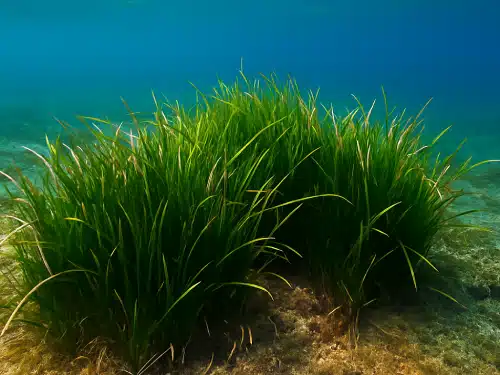

Formentera, September 12, 2025
Even though summer hasn’t officially ended, it’s safe to say that Formentera has experienced several months of unusually high temperatures, both on land and at sea. The island recorded above-average temperatures and a record number of tropical nights — a phenomenon that clearly reflects the impact of climate change in the region.
At the same time, the waters of the western Mediterranean reached alarming levels. With temperatures exceeding 29 degrees Celsius, the sea showed anomalies of up to two degrees above what would be expected for this time of year. Far from being an isolated event, this rise has become a recurring trend that intensifies year after year.
The sustained increase in sea temperature is already having visible consequences on marine biodiversity. Some species have migrated to other latitudes, while others, unable to move, suffered intense physiological stress. Among them, Posidonia oceanica is believed to be one of the main casualties of this process.
Posidonia, considered a fundamental pillar for the health of the Balearic marine ecosystem, has started to show alarming signs of deterioration. Its meadows not only serve as shelter and food for numerous species, but they also protect the coastline from erosion. The threat this plant is facing is therefore not only an ecological issue, but also a social and economic problem for Formentera.
A Summer Marked by Intense Heat
Records from the Spanish State Meteorological Agency confirmed that summer in Formentera was significantly warmer than the historical average. In some areas, anomalies reached up to two degrees above normal. In addition, tropical night records were broken, with minimum temperatures sometimes not dropping below 25 degrees.
This constant heat on land was mirrored at sea. Surface waters of the western Mediterranean experienced unprecedented warming, with peaks surpassing 30 degrees. According to researchers, this phenomenon is no longer an exception but a recurring pattern that threatens the stability of marine ecosystems.
The Direct Impact on Posidonia
Unlike species that have migrated to cooler waters, Posidonia oceanica is unable to move. Experts have warned that this plant begins to die if it remains in waters above 28 degrees for more than two weeks. What is alarming is that these episodes, once rare, now occur every summer.
Thermal stress has already triggered atypical flowering in posidonia — a desperate reproductive strategy to counteract mortality. However, the pace of marine warming threatens to outstrip its ability to adapt. The loss of posidonia meadows would have serious consequences: reduced biodiversity, increased coastal erosion, and the weakening of a key ecosystem in the Balearic Mediterranean.
Climate Change and an Uncertain Future
Scientists agree that the process of sea warming cannot be reversed in the short term. While cutting CO₂ emissions could slow the trend, returning to pre-industrial conditions would take thousands of years. In the meantime, the Mediterranean will continue to absorb the excess heat generated by the greenhouse effect.
Posidonia now finds itself at a crossroads. Its survival will depend on its biological ability to adapt — an uncertain factor in the face of such an accelerated warming process. What’s at stake is not just the preservation of a single species, but the stability of an entire ecosystem on which Formentera’s coasts and biodiversity depend.

I’m Ramón Tur, the person behind everything written and photographed on this website about Formentera. I discovered the island in 1972 when my parents, aboard the mythical Joven Dolores, took me on vacation from Ibiza for the first time, and it was love at first sight that has only grown stronger over time, making Formentera my place of residence for many years now. If you wish, you can follow me on Instagram @4mentera.com_
If you're planning to visit Formentera, make sure to check out our discount codes section first.





